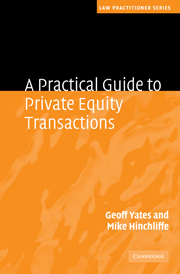Book contents
- Frontmatter
- Contents
- List of figures
- Foreword
- Preface and acknowledgments
- Table of cases
- 1 An introduction to private equity
- 2 The deal process and preliminary matters
- 3 Transaction structures and deal documents
- 4 Acquisition issues
- 5 Equity documentation
- 6 Debt funding
- 7 Employment-related issues
- 8 Pensions
- 9 Tax on private equity transactions
- 10 Public-to-private transactions
- 11 Living with the investment
- 12 Secondary buyouts
- 13 Exits
- Index
6 - Debt funding
Published online by Cambridge University Press: 04 May 2010
- Frontmatter
- Contents
- List of figures
- Foreword
- Preface and acknowledgments
- Table of cases
- 1 An introduction to private equity
- 2 The deal process and preliminary matters
- 3 Transaction structures and deal documents
- 4 Acquisition issues
- 5 Equity documentation
- 6 Debt funding
- 7 Employment-related issues
- 8 Pensions
- 9 Tax on private equity transactions
- 10 Public-to-private transactions
- 11 Living with the investment
- 12 Secondary buyouts
- 13 Exits
- Index
Summary
Introduction
In this chapter, we turn to look in more detail at the debt financing aspects that need to be considered in the context of the acquisition of Target. We have already seen in earlier chapters that private equity investors will, in all but a small minority of situations, look to the debt finance markets for a significant proportion of the funding required to meet the purchase price of Target, and to supply the necessary working capital facilities that will support Target's operations post-acquisition.
The nature and extent of debt finance packages supporting private-equity-backed acquisitions has evolved rapidly in recent times and, it would be fair to say, since the turn of the millennium we have already seen debt financing structures go more than full circle in terms of quantum, leverage, pricing and gearing. This has been the result of a period of sustained growth in the private equity and leveraged finance markets followed by a rather abrupt retrenchment in the marketplace sparked by the widely reported credit crunch. As a result (and to ensure the reader has a full understanding of what has and will shape the nature of debt funding packages in the future), in this chapter we seek to provide a brief overview of market trends in this financing sector since the early part of the new millennium, together with a short analysis of how these trends were affected by the credit crunch which ensued in the latter part of 2007.
- Type
- Chapter
- Information
- A Practical Guide to Private Equity Transactions , pp. 170 - 202Publisher: Cambridge University PressPrint publication year: 2010



